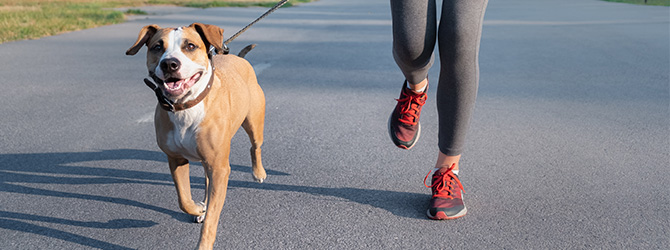Running with your dog: on your barks, get set, go!
2 min read
If you’re a keen runner and a dog owner, you’re on to a winner. Running with your dog is a great way of bonding with your pet while having fun, keeping fit, and maintaining a healthy lifestyle. And according to 2016 research, which found that more than 3.8 million pet dogs in the UK are overweight or obese, it’s a great way to keep your pet pooch fit, too.
The massive growth in the popularity of park runs means running with your pet can be a sociable experience. Why not get together with a group of your dog-loving friends to exercise your dogs and work on your personal best at the same time?
How to run with your dog
The success of running with your dog will depend on the breed of dog you own. As you might expect, dogs with longer legs make the best running partners, while small breeds with their little legs will struggle to keep up.
Interval training can be a good solution for dogs with short legs, like pugs and bulldogs, which aren’t suited for longer sprints. Try jogging for five minutes then walking for ten, to give your pet pooch a chance to get his breath back.
The best dogs to go running with
The best long-legged breeds for running include:
- Labradors
- Golden retrievers
- Huskies
- Border collies
- German shorthaired pointers
Should I use a lead?
Experts suggest using a regular lead, or leash, rather than a retractable lead when you’re out running with your dog. Alternatively, visit your local pet store or search online for a running harness for your dog – these have been designed to reduce chafing and keep your dog comfortable while he exercises. Never use a collar that’s designed to tighten – such as a slip collar – for obvious reasons.
Running with your dog at night
Just like today’s exercise gear often involves reflective strips and even built-in LED lighting for night-time running, there’s plenty of reflective kit available for your dog, too. A quick search on Google Shopping, Amazon, eBay, or any one of a number of online pet stores will bring up dozens of options for keeping your late-night running partner safe in the dark.
Top tips for running with your dog
- Warm up with 10 minutes of brisk walking before you increase the pace, and cool down with a 10-minute walk as you approach home.
- Use reflective gear if you’re running after dark.
- Give your dog a bathroom break before you start your run.
- Pay attention to any signals that your dog is tiring – and don’t overdo it.
- Use a collar and lead that’s suitable for exercise.
- Puppies shouldn’t start running until they’re physically mature, so wait until your dog is at least a year old before kick-starting your exercise regime. Or..(Puppies’ exercise should be moderated until they’re physically mature so avoid lengthy runs or periods of intense exercise until then)
- Running ability depends on your dog’s age and general health, so take it easy with an older dog – particularly one with arthritis, or with brachycephalic breeds ( bulldogs, pugs and others which might have compromised airways)
- Remember – your pooch gets as thirsty as you do, so offer your dog water every 20 minutes or so.
- Even the fittest dog will tire by around the five-mile mark, so put a limit to your exercise.
- Get your dog checked out by your vet before embarking (sorry) on a new exercise regime – especially if you’re going to be putting in hard graft.
Need advice on running with dogs?
For expert advice on running with your dog, contact your local vet.
Find your nearest vet using our Find a Vet page, or speak to a vet online using Online Vets.

